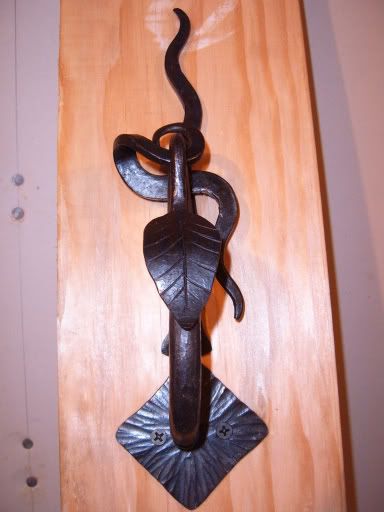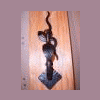-
Posts
34 -
Joined
-
Last visited
Content Type
Profiles
Forums
Articles
Gallery
Downloads
Events
Posts posted by wapiti_forge
-
-
Do you have a carving block? it looks a little twisted. That happens when you try to do the punch work in the vice without a block. They are really easy to make.
I really like it though. Very cool. -
My dentist swears up and down that I grit my teeth when I sleep. I've told him for a few years that he's crazy.
Today i realized I clench my teeth when I'm working on the anvil. Can't help it, it just happens. I stay quite relaxed when I'm working, but my jaw really tightens up. Once I realized it I tried to not do it, but it was really hard. That will take a lot of conscious effort while I'm working.
Anybody else do this? -
Depends on what you're making. I absolutely never have that attitude until the bitter end when making a custom knife. However, performance is crucial, and what I consider "good enough" on a knife is beyond anal retentive to most people. Artistic iron work is different.... good enough is a common phrase in my smithy when I'm doing anything other than knives.
-
You could use plumb brown gun finish on them perhaps. It induces oxidation and holds oil really well. Or, just oil them after they get a rusty patina.
-
Thanks for all the complements folks. What a warm welcome. I hope to share some of my future projects with you.
Take care,
Brook -
You can't go wrong with a blacksmith knife style letter opener.
-
You can buy a few pounds of satanite powder for the same price as a few tubs of furnace cement. You also might consider ITC-100. Both are easier to mix and apply. They also last longer in the forge. Furnace cement will get brittle if you forge often and will start to fall apart.
Having said that, I know a few full time blacksmiths that don't even bother with coating their ceramic wool anymore. Their forge bodies are roughly 12-14" in diameter, lined with about 1.5-2" of wool. However, they do not forge weld in them. They could probably still weld in them if they at least coated the bricks on the bottom with ITC, or even furnace cement. The flux eats up the wool really fast. -
The rough sand finish you're talking about could be pitting, but I can't tell without a photo. Most of the old Swage blocks I've seen were less than perfect and often had an orange peel like surface.
That is a good price if they are heavy.
I'd buy all three and resell two. The profit would make it worth it, and you'd get a free swage block in the process. They also make great trade stock. -
Deleted.
Good luck. -
Clear engine enamel from Napa autoparts.
-
Look at Wayne Goddard's $50 Knife Shop. It will answer all of your questions and help you get started with little investment.
It is on Google Books for free. Some pages are missing though.
It runs for about $20 online.
Good luck.
- Brook -
There are tons of great blacksmithing 101 videos on the web. Youtube is a great place to start. Also check your local library. A rainy afternoon, some hot coffee and a great book will give you a good basic working knowledge.
Here are a few books in publication that you can view on Google Books. The Modern Blacksmith is often at most libraries nowadays.
The complete modern blacksmith - Google Books
New edge of the anvil: a resource ... - Google Books
Good luck! -
Just start working on the anvil. Developing proper hammer control is more important when you begin. You could spend hours grinding, welding, perhaps even forging your horn to a perfect point, then screw up all your work because you haven't learned to control your hammer. People who have worked in construction, or big wall climbers who climb nail up routes, etc. often already have strong hammer skills from the get go, but still need refinement. You could be in this category, I don't know.
You won't have a huge need for a fine point on your anvil right now anyway. If you do, just forge down a piece of large round stock and stick it in your vice when you need a fine pointed horn. It would be a good introductory project. If you do enjoy blacksmithing, you'll probably upgrade to a better anvil down the road.
I'm not sure if you're anvil is cast iron or not. I can't remember from the original post. If it is a cheap cast iron anvil you won't be able to forge the point out anyway.
Happy hammering,
Brook -
If there's one thing I appreciate, it's well formed knockers. I'm sure if you show up, we can find someone to sponsor you as a guest. Or look me up at the conference and i'll make you my guest. PM me if you like.
Thank you very much! That is a kind offer. PM inbound.
- Brook -
Good thing I live in the sticks!
-
Thanks for all the kudos. I will probably make some traditional nails tomorrow.
You can't see it but it has deep fullered radius about 1/2" from the striking point.
I haven't decided yet on the conference. I'm going to the UW full time and I haven't been able to drum up the fees for a NWBA membership since the dues went up. I'd really like to go to network if for nothing else. I live on the GI bill and I get a few knife and blacksmithing orders here and there, so events like the conference are on hold until I'm done with school in a few months. -
Hi folks,
I'm new here, so I figured I'd share some of my recent work. I banged out this door knocker yesterday and thought you might like to see it. It's 11" tall and 3" wide.
Thanks for a great site.
Brook
-
I have had this happen before too. Even after letting it sit for a few weeks it would still bubble up. This usually happens when I used stove cement that I watered down so I could apply it.
Satanite doesn't do this.
I found that it will bubble up and look really ugly, but after running the forge for a while the bubbles will go back down. In fact, after everything was up to temperature, I could use a piece of steel and push the bubbles down flat. They usually don't come back after that.
Good luck. -
I happen to know a bit about ballistas and seriously advise against it. A very good friend of mine is a machinist who has built full scale ballista replicas. Aside from the fact that it took him months to complete his first ballista, he went through several arm designs before he found one that wouldn't break.
This project will probably take longer than you think, and your estimate for materials is way off. I don't see how you could build one for a reasonable price and make any profit unless you seriously cut corners, which is not an option when building siege weapons.
I've shot my friend's ballista and it is extremely powerful and has the potential to break during wind up or firing. The bolt is not nearly as dangerous as the ballista itself.
Sorry to be so astute but this is a risky one.
Take care,
Brook -
I line my forge with kitty litter. It soaks up the slag/flux from forge welding and definitely catches the errant copper drip when I'm making mokume. I replace it ever few weeks and have zero issues with contamination when making damascus.
-
He didn't say edge. He said the whole bottom was wore flat. By what? Wouldn't it have to be on something moving for a long time to wear flat? I just don't get it. I've seen hundreds of anvils, same as a lot of folks here, but never saw one where the bottom was worn. Only the top.
Gobbler
Could be that the anvil sat out behind a barn for many years. The base could pit where it sat in the dirt/grass, giving the appearance of wear. I've seen old rusty wrought iron that appeared to be worn, but closer inspection showed the mass wore down due to decades of pitting. -
Check out Alpha Knife Supply in addition to the above mentioned suppliers. He doesn't always have the best selection, but often has very good deals.
Also keep your eye on Ebay. You can get pretty good deals on grinding belts, handle materials and other items peculiar to knife making at very reasonable prices. -
Yeah, the penny weld was common before they changed the penny composition. Now it's mostly antimony, I think.
You could maybe etch the copper off the surface using a strong acid. Ferric Chloride would probably work since it is designed to dissolve copper traces on circuit boards. Just an idea. If you do choose to use any acids, make sure you follow all safety precautions and completely avoid the method if you have no idea what you are doing. -
Maybe I'll get crafty and wire a contact on the scale needle so a buzzer will go off when it hits a certain weight.
They also have magnetic tank gauges at the hardware store. I don't know how accurate they are when the tank starts to freeze though.
Another idea I've had for years but never tried was to submerge the tank in a large bucket of water. As the tank gets empty its bouyancy increases and will slowly rise. You could mark the tank with a piece of tape. When the tape hits the top of the water you'll know you only have x amount of time before you're out.


I clench my teeth working on the anvil
in Blacksmithing, General Discussion
Posted
I used to clench my teeth when I'd pull a hard move when I climbed a lot. It was pretty bad on long leads in the valley. Glad I'm not standing on long strings of heads and hooks anymore.
I swing pretty hard when I'm reducing large stock and that's when I do it. I paid close attention this afternoon.